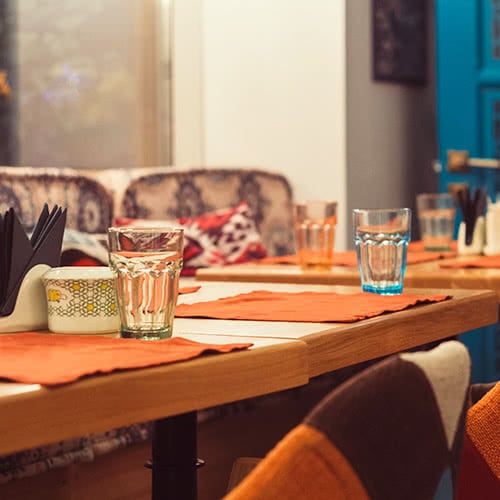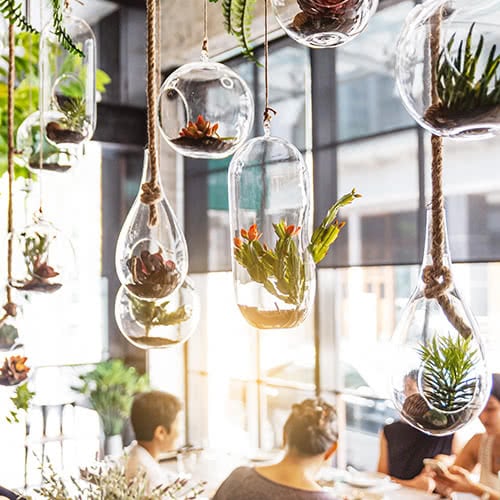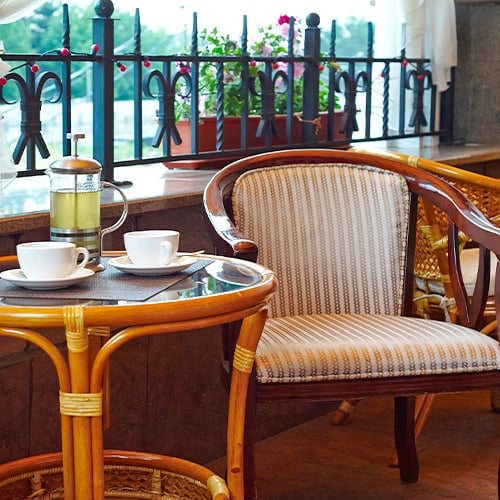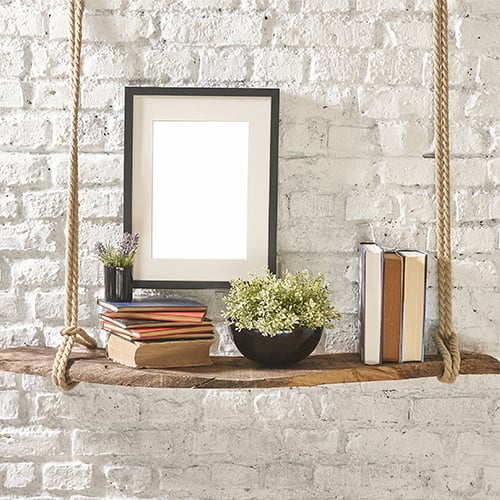A visit to a local coffee shop is a daily part of many people's lives. Designing a cafe theme that resonates with your guests goes a long way in winning customer loyalty. Whether you’re just opening a coffee shop or looking to upgrade your decor and design, explore our coffee shop ideas below to glean the inspiration you need to create an alluring space.
Shop All Coffee Shop Supplies
Coffee Shop Design Ideas
Your coffee shop interior sets the tone of your space and should be consistent with your brand. Consider the following themes to bring your brand, concept, and values to light.
1. Rustic Coffee Shop Interior

A rustic interior design features a range of organic, natural features that are reminiscent of the outdoors. It may utilize farmhouse decor or may veer towards an in-the-woods feel. Below are some design elements you might see in a rustic coffee shop.
- Color palette: neutral colors, such as tan, cream, brown, and green
- Lots of natural features, including potted plants, plant walls, and flowers
- Mix of wood types and finishes, including reclaimed wood
- Farmhouse components, like jars or vintage milk crates
- Emphasis on rugged beauty
- Raw wood, stone, metal
- Indoor picnic table
- Wicker baskets and wicker furniture
- Galvanized planters
- Chalkboard
2. Industrial-Style Coffee Shop Interior

An industrial theme takes inspiration from warehouses, factories, and other industrial spaces and is one of the most popular coffee shop themes. Industrial-style cafes feature an open floor plan to emphasize the exposed architectural structure while staying true to the design's origins. Below are some design elements you might see in an industrial coffee shop.
- Color palette: gray, black, tan, white, and darker tones, like maroon
- Exposed architecture, like pipes, brick, ceiling beams, iron reinforcements, and weathered wood
- Bare Edison light bulbs and cage lighting
- Rustic wood furniture with metal accents
- Squared lines and block shapes
- Concrete flooring
- Use of contemporary materials like leather, copper, and stone
- Juxtaposition of timeworn and modern components, such as a modern lamp atop a vintage side table
3. Modern Coffee Shop Interior

Modern-style decor grew in popularity in the first half of the 20th century. A core principle of this design style is that form should follow function, meaning that every piece of furniture and decoration should be simple with a practical, intentional purpose. Below are some design elements you might see in a modern coffee shop.
- Color palette: brown, taupe, cream, or pure white
- Geometric furniture
- Lack of intricate details
- Blend of comfortable and sophisticated styles
- Bold, vivid accessories, such as a brightly colored sofa, pillows, or a piece of abstract art
- Textured fabrics like crushed velvet, linen, or wool
- Cool metal accents, like stainless steel, nickel, and chrome
- Very light or dark wood tones
- Clean and organized
4. Minimalist Coffee Shop Interior

Inspired by Scandinavian and Japanese interiors, a minimalist design uses a less-is-more approach by only using pieces that serve a purpose to keep the space simple and uncluttered. An easy way to make your minimalist design feel soothing and inviting rather than cold and sterile is to accentuate the unique architectural features of your space. Do this by choosing paint colors that brighten the space, creating an open, airy floorplan that is easy to navigate, or using different textures to add dimension to your monochromatic look. Below are some design elements you might see in a minimalist coffee shop.
- Color palette: neutral colors, such as white, creams, and grays
- Clean lines and an uncomplicated, streamlined layout
- Pendant lights and natural lighting
- Glass walls
- Straight-sided furniture with smooth surfaces
- Limited decorative objects
- Natural materials, such as wood furniture and stoneware dinnerware
- Comfortable seating
5. Mid-Century Coffee Shop Interior

Lasting from the mid-1930s through the 60s, mid-century design is characterized by the exploration of new materials in light of new technology while still honoring the traditional ones. Materials were celebrated for their uniqueness rather than designed to imitate. Similar to modern design, mid-century decor emphasizes function over form. Below are some design elements you might see in a mid-century coffee shop.
- Color palette: natural hues mixed with bold pops of color, such as smoky gray accented by avocado green, mustard yellow, or pumpkin orange
- Combination of natural and man-made materials
- Sleek lines and geometric shapes
- Tables and chairs with tapered legs
- Ergonomic furniture
- Wood and tweed textures
- Vivid accent colors
- Sculptural art
6. Eclectic Coffee Shop Interior

An eclectic theme combines different design styles, prints, patterns, and textures that would not ordinarily complement one another to create a one-of-a-kind aesthetic. Eclecticism is not synonymous with cluttered and is rather a carefully curated look that can showcase your business’s personality through varied design styles. To create a cohesive eclectic look, it is best to choose a unifying color palette and repeat those colors throughout your design. Below are some design elements you might see in an eclectic coffee shop.
- Color palette: neutral colors with hints of bold colors mixed in, such as white or gray with various shades of red, blue, and green
- Mismatched furniture styles, such as antique tables paired with modern chairs
- Bold wallpaper
- Patterned floor tiles
- Gallery walls
- Art from different eras
- Neon signs
- Patterned or brightly-colored dinnerware
7. Nature-Inspired Coffee Shop Interior

A nature-inspired or biophilic design draws inspiration from the outside world and brings it inside. It is becoming a popular design trend for foodservice establishments as sustainability becomes more important to consumers. In addition to adding a variety of botanicals, opt for sustainable and renewable materials to furnish your space and be thoughtful about the types and amount of disposables you use. Below are some design elements you might see in a nature-inspired coffee shop.
- Color palette: colors that appear in nature, such as creams, grays, greens, and blues (draw from your favorite natural environment for inspiration!)
- Various species of plants, trees, and greenery
- Hanging plants from the ceiling
- Environmentally-friendly packaging
- All-natural materials, such as wood, stone, terracotta, marble, and bamboo
- Lots of natural light from unobstructed windows and skylights
- Natural materials, such as wood furniture and stoneware dinnerware
- Airy, uncrowded feel
- Organic shapes, such as irregular-shaped furniture or driftwood decor
- Propagation wall
8. Vintage Coffee Shop Interior

Vintage decor draws inspiration from the past and may include styles from various decades. It emanates a romantic, charming atmosphere with antique pieces emphasizing ornate, elegant patterns and designs. Below are some design elements you might see in a vintage coffee shop.
- Color palette: pastel or faded colors, such as sky blue, peach, light orange, blush pink, and sea green
- Floral wallpaper and accents
- Checkered tablecloths and napkins
- Pieces with ornate features, like embroidered doilies, hoops, quilts, or couches and chairs with intricate patterns
- Cedar chests
- Vintage luggage
- China dishes as decoration or for serving
- Cafe curtains
- Canisters for holding coffee, tea, flour, sugar
- Victorian-style or distressed couches and chairs
- Mahogany wood
- Chandeliers or stained-glass lamps
9. Cozy Coffee Shop Interior

Influenced by country living and European architecture, a cozy coffee shop aesthetic emphasizes comfort, warmth, and relaxation. A stark contrast to modern design, cozy cafe interiors feature casual, lounge-worthy furnishings that invite guests to stay awhile and antiqued textures for an unfussy, laid-back feel. Below are some design elements you might see in a cozy coffee shop.
- Color palette: neutral colors, muted botanical colors, or dark and moody colors
- Warm, soft lighting via candles, fireplace, or string lights
- Weathered wood, wicker, and natural stone
- Mix of classic patterns, such as floral, stripes, and gingham
- Rustic, antique touches, such as exposed ceiling beams or antique table vases
- Botanical accents
- Plush couches and large armchairs for seating
- Natural, laidback feel
- Soft finishes
- Bookshelves and reading nooks
Coffee Shop Interior Decor Basics
Below are five basic tips to remember when setting up your coffee shop interior.

- Reflect your brand and mission. Your cafe will be memorable if it has a strong brand that is palpable through your decor, employees, service, and items offered. Your brand includes your restaurant’s concept, identity, personality, and mission. Your cafe decor and coffee shop interior design should be consistent with and enhance your brand, emanating an ambiance that is apparent to your patrons.
- Connect with your community. Interacting with the community is a great way to attract customers, and an easy way to do that is by displaying shoppable decor. Partner with local artists, boutiques, and plant nurseries by using their for-sale items as decor in your shop. Not only will this keep your interior looking fresh with new pieces, but it will also encourage patrons to routinely stop in and shop local!
- Be wise with your lighting. When possible, make use of natural lighting to take advantage of organic light and conserve energy. During the day, cool lights are also a great option, as they illuminate areas with similar tones to daylight. To create a comforting atmosphere in the evening, warm, low lighting is ideal because it creates a more gentle contrast from the darkness. However, depending on your coffee shop's brand, you might choose to always utilize either cool or warm tones.
- Keep it comfortable. From the guest working on a laptop to the group of friends catching up, coffee shops are the go-to spot for a wide range of customers. Depending on your cafe’s concept, the front-of-house layout and choice of seating are just two factors to consider when nailing down your design to ensure your sit-down guests are comfortable during their stay.
- Make it Instagrammable and interactive. The trend of sharing their experiences with others through images on social media platforms like Instagram has transitioned into a standard practice for customers. Outfitting your coffee shop interior with eye-catching, unique features, such as a social media-friendly accent wall, contributes to creating a full-fledged experience for your guests while also serving as a free marketing tactic.
Coffee Shop Decor Accents

Depending on your cafe, certain parts of your coffee shop’s personality, values, and mission statement may or may not always be apparent in the color scheme and theme of your coffee shop decor. Choosing your accents wisely ensures that your brand and values come across to your patrons. Additionally, your coffeehouse decor can make your space more engaging and immersive.
- Books and magazines: Set out books that relate to your brand and mission. If you support local farms, include books on sustainable farming. If you were inspired by growing up in the Midwest, include books about your hometown. You can even include an eclectic mix of books to satisfy a range of customer interests.
- Servingware and tableware: The style and color of your mugs and dishes can bring your brand's personality to light. For example, an eclectic coffee shop might include brightly-colored mugs and saucers, while a rustic cafe may offer neutral-colored mugs and mason jars for water.
- Artwork: Incorporate art that relates to your values, mission, and brand. Choose local artists to show that you are part of the local community or if you emphasize fair trade. If a cause is dear to you, such as civil rights, include artwork that expresses it, such as photography of the civil rights movement or artwork that depicts inclusivity.
- Games: Include entertainment that is specific to your brand and atmosphere. For example, if your cafe celebrates the cozy concept, include games like Monopoly or chess to encourage guests to stay, relax, and enjoy.
- Music: Music can bring out a specific vibe in your cafe. You can alter your music playlist based on your brand or the time of day. If you operate a rustic cafe, try playing grassroots or acoustic music. If your spot is modern, you might choose more upbeat, popular songs. You may also choose to change your music based on your customer base. For example, if your cafe is full of guests working on their computers, choose non-distracting music like piano classics or songs without lyrics.
By nailing down your coffee shop’s concept and selecting decor to express it, you can be well on your way to creating a successful business. Your menu layout and coffee equipment should also reflect your design style to stay consistent throughout the vision. Some of the most unique cafe interiors pull components from several different themes. Always feel free to customize your coffee shop to your desires and brand while using these themes as guidelines or inspiration.



